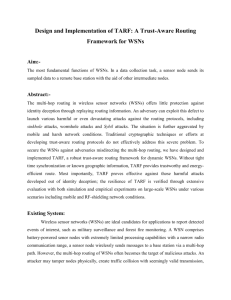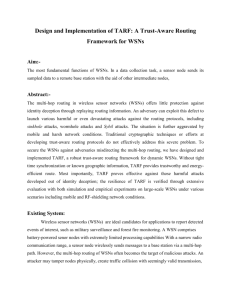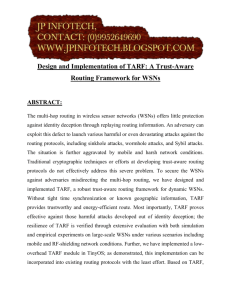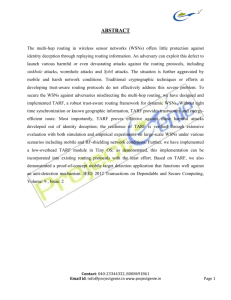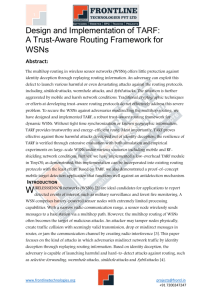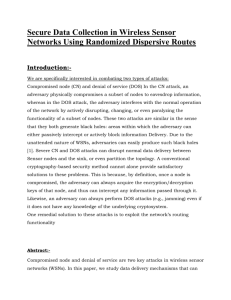A Network Coding Equivalent Content Distribution
advertisement
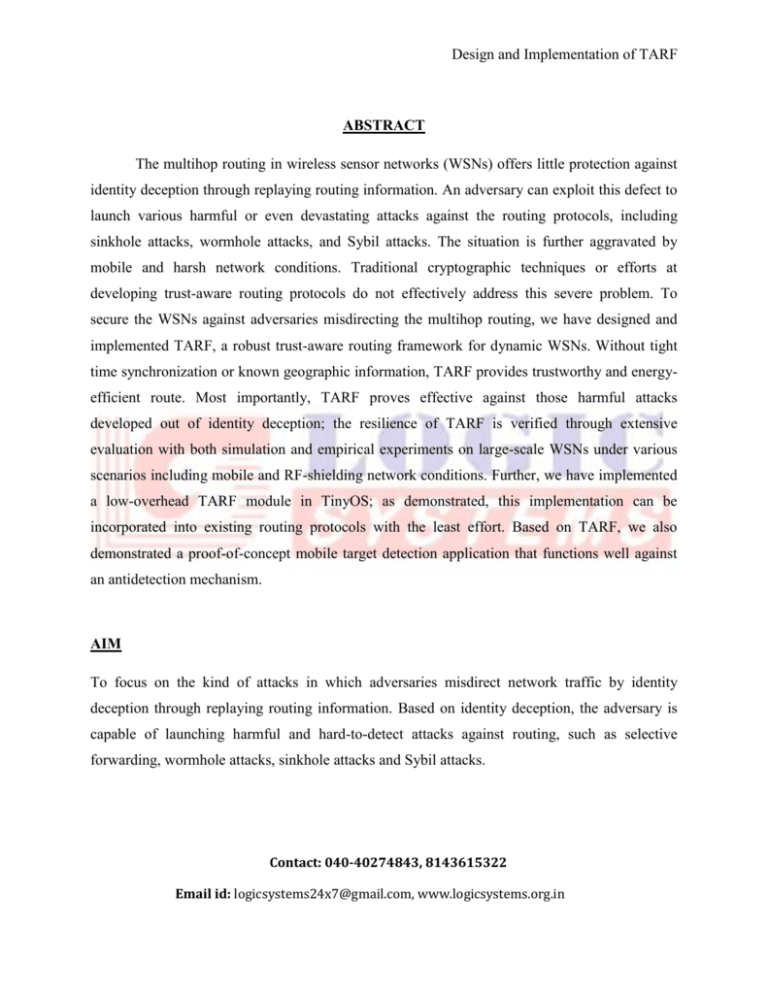
Design and Implementation of TARF ABSTRACT The multihop routing in wireless sensor networks (WSNs) offers little protection against identity deception through replaying routing information. An adversary can exploit this defect to launch various harmful or even devastating attacks against the routing protocols, including sinkhole attacks, wormhole attacks, and Sybil attacks. The situation is further aggravated by mobile and harsh network conditions. Traditional cryptographic techniques or efforts at developing trust-aware routing protocols do not effectively address this severe problem. To secure the WSNs against adversaries misdirecting the multihop routing, we have designed and implemented TARF, a robust trust-aware routing framework for dynamic WSNs. Without tight time synchronization or known geographic information, TARF provides trustworthy and energyefficient route. Most importantly, TARF proves effective against those harmful attacks developed out of identity deception; the resilience of TARF is verified through extensive evaluation with both simulation and empirical experiments on large-scale WSNs under various scenarios including mobile and RF-shielding network conditions. Further, we have implemented a low-overhead TARF module in TinyOS; as demonstrated, this implementation can be incorporated into existing routing protocols with the least effort. Based on TARF, we also demonstrated a proof-of-concept mobile target detection application that functions well against an antidetection mechanism. AIM To focus on the kind of attacks in which adversaries misdirect network traffic by identity deception through replaying routing information. Based on identity deception, the adversary is capable of launching harmful and hard-to-detect attacks against routing, such as selective forwarding, wormhole attacks, sinkhole attacks and Sybil attacks. Contact: 040-40274843, 8143615322 Email id: logicsystems24x7@gmail.com, www.logicsystems.org.in Design and Implementation of TARF INTRODUCTION Wireless sensor networks (WSNs) are ideal candidates for applications to report detected events of interest, such as military surveillance and forest fire monitoring. A WSN comprises batterypowered senor nodes with extremely limited processing capabilities. With a narrow radio communication range, a sensor node wirelessly sends messages to a base station via a multi-hop path. However, the multi-hop routing of WSNs often becomes the target of malicious attacks. An attacker may tamper nodes physically, create traffic collision with seemingly valid transmission, drop or misdirect messages in routes, or jam the communication channel by creating radio interference. PROBLEM STATEMENT As a harmful and easy-to-implement type of attack, a malicious node simply replays all the outgoing routing packets from a valid node to forge the latter node’s identity; the malicious node then uses this forged identity to participate in the network routing, thus disrupting the network traffic. Even if this malicious node cannot directly overhear the valid node’s wireless transmission, it can collude with other malicious nodes to receive those routing packets, which is known as a wormhole attack. A node in a WSN relies solely on the packets received to know about the sender’s identity, replaying routing packets allows the malicious node to forge the identity of this valid node. After “stealing” that valid identity, this malicious node is able to misdirect the network traffic. It may drop packets received, forward packets to another node not supposed to be in the routing path, or form a transmission loop through which packets are passed among a few malicious nodes infinitely. Sinkhole attacks can be launched after stealing a valid identity, in which a malicious node may claim itself to be a base station through replaying all the packets from a real base station. Such a Contact: 040-40274843, 8143615322 Email id: logicsystems24x7@gmail.com, www.logicsystems.org.in Design and Implementation of TARF fake base station could lure more than half the traffic, creating a “black hole.” This same technique can be employed to conduct another strong form of attack Sybil attack: through replaying the routing information of multiple legitimate nodes, an attacker may present multiple identities to the network. A valid node, if compromised, can also launch all these attacks. PROBLEM SOLUTION To protect WSNs from the harmful attacks exploiting the replay of routing information, designed and implemented a robust trust-aware routing framework, TARF, to secure routing solutions in wireless sensor networks. Based on the unique characteristics of resource-constrained WSNs, the design of TARF centers on trustworthiness and energy efficiency. TARF requires neither tight time synchronization nor known geographic information. TARF proves resilient under various attacks exploiting the replay of routing information, which is not achieved by previous security protocols. Even under strong attacks such as sinkhole attacks, wormhole attacks as well as Sybil attacks, and hostile mobile network condition, TARF demonstrates steady improvement in network performance. Implemented a ready-to-use TARF module with low overhead, which as demonstrated can be integrated into existing routing protocols with ease. Contact: 040-40274843, 8143615322 Email id: logicsystems24x7@gmail.com, www.logicsystems.org.in Design and Implementation of TARF EXISTING SYSTEM: In the existing system, the multihop routing of WSNs often becomes the target of malicious attacks. An attacker may tamper nodes physically, create traffic collision with seemingly valid transmission, drop or misdirect messages in routes, or jam the communication channel by creating radio interference. Most existing routing protocols for WSNs either assume the honesty of nodes and focus on energy efficiency, or attempt to exclude unauthorized participation by encrypting data and authenticating packets. Examples of these encryption and authentication schemes for WSNs include TinySec, Spins, TinyPK, and TinyECC. In addition to the cryptographic methods, trust and reputation management has been employed in generic ad hoc networks and WSNs to secure routing protocols. Basically, a system of trust and reputation management assigns each node a trust value according to its past performance in routing. Then such trust values are used to help decide a secure and efficient route. However, the proposed trust and reputation management systems for generic ad hoc networks target only relatively powerful hardware platforms such as laptops and smartphones. DISADVANTAGES OF EXISTING SYSTEM: Various types of attacks are avoided Trust and reputation management systems cannot be applied to WSNs due to the excessive overhead for resource-constrained sensor nodes powered by batteries. Contact: 040-40274843, 8143615322 Email id: logicsystems24x7@gmail.com, www.logicsystems.org.in Design and Implementation of TARF PROPOSED SYSTEM: In the proposed system , to secure the WSNs against adversaries misdirecting the multihop routing, we have designed and implemented TARF, a robust trust-aware routing framework for dynamic WSNs. To protect WSNs from the harmful attacks exploiting the replay of routing information, TARF, a robust trust-aware routing framework is designed, to secure routing solutions in wireless sensor networks. TARF can be developed into a complete and independent routing protocol, the purpose is to allow existing routing protocols to incorporate our implementation of TARF with the least effort and thus producing a secure and efficient fully-functional protocol. ADVANTAGES OF PROPOSED SYSTEM: Based on the unique characteristics of resource-constrained WSNs, the design of TARF centers on trustworthiness and energy efficiency. TARF requires neither tight time synchronization nor known geographic information. TARF proves resilient under various attacks exploiting the replay of routing information, which is not achieved by previous security protocols. Even under strong attacks such as sinkhole attacks, wormhole attacks as well as Sybil attacks, and hostile mobile network condition, TARF demonstrates steady improvement in network performance. TARF module proves low overhead. Contact: 040-40274843, 8143615322 Email id: logicsystems24x7@gmail.com, www.logicsystems.org.in Design and Implementation of TARF MODULES: Node Initialization Route Selection Energy Watcher Trust Manager MODULES DESCRIPTION: Node Initialization In this module, We design a wireless sensor network, with base station and other sensor nodes. For a node N, a neighbor (neighboring node) of N is a node that is reachable from N with onehop wireless transmission. Route Selection For a TARF-enabled node N to route a data packet to the base station, N only needs to decide to which neighboring node it should forward the data packet considering both the trustworthiness and the energy efficiency. Once the data packet is forwarded to that next-hop node, the remaining task to deliver the data to the base station is fully delegated to it, and N is totally unaware of what routing decision its next-hop node makes. N maintains a neighborhood table with trust level values and energy cost values for certain known neighbors. Energy watcher For a node N, the energy cost of a neighbor is the average energy cost to successfully deliver a unitsized data packet with this neighbor as its next-hop node, from N to the base station. That energy cost is denoted as E Contact: 040-40274843, 8143615322 Email id: logicsystems24x7@gmail.com, www.logicsystems.org.in Design and Implementation of TARF Trust Manager For a node N, the trust level of a neighbor is a decimal number in [0, 1], representing N’s opinion of that neighbor’s level of trustworthiness. Specifically, the trust level of the neighbor is N’s estimation of the probability that this neighbor correctly delivers data received to the base station. That trust level is denoted as T. SYSTEM REQUIREMENT SPECIFICATIONS: HARDWARE REQUIREMENTS: • System : Pentium IV 2.4 GHz. • Hard Disk : 40 GB. • Floppy Drive : 1.44 Mb. • Monitor : 15 VGA Colour. • Mouse : Logitech. • Ram : 512 Mb. SOFTWARE REQUIREMENTS: • Operating system : - Windows XP. • Coding Language : JAVA REFERENCE: Guoxing Zhan, Weisong Shi, and Julia Deng, “Design and Implementation of TARF: A TrustAware Routing Framework for WSNs”, IEEE TRANSACTIONS ON DEPENDABLE AND SECURE COMPUTING, VOL. 9, NO. 2, MARCH/APRIL 2012. Contact: 040-40274843, 8143615322 Email id: logicsystems24x7@gmail.com, www.logicsystems.org.in
